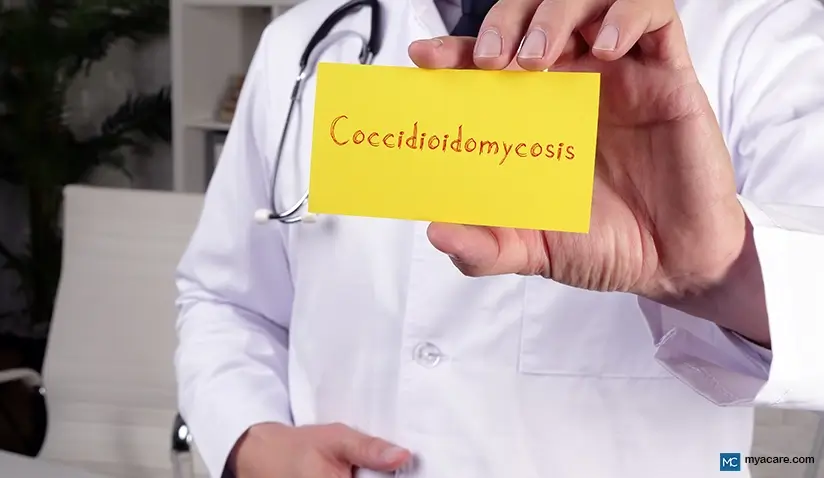What Is Coccidioidomycosis?

Coccidioidomycosis is an illness that is caused when a person inhales the spores of the Coccidioides fungus. Coccidioidomycosis pronunciation is challenging and many may simply call the illness by its other name, namely, valley fever.
The Coccidioides fungus actually lives in soil in the drier western regions of North America and parts of South America. The coccidioidomycosis morphology varies when the fungus is growing in the wild. It is the spore part called the arthroconidia that infects people.
When the spores are inhaled by someone, the fungus causes an inflammatory reaction. This is most often in the lungs and is called pulmonary coccidioidomycosis. This inflammation in the lungs can result in lesions being formed compromising the respiratory system.
Coccidioidomycosis Symptoms
Some of the symptoms of this infection are similar to other respiratory infections such as the flu or bronchitis. Further testing may be needed for an individual who has any of these symptoms, particularly if they do live in an area such as California, Arizona, Mexico or parts of South America, where valley fever does occur.
The symptoms of coccidioidomycosis include the following:
- Fever and chills
- Coccidioidomycosis pulmonary effects include:
- Pain in the chest
- Coughing up blood
- Coughing up sputum
- Coccidioidomycosis rash: Skin rashes can happen in some people who are infected with the fungus and it is often a sign of disseminated infection (an infection that has spread).
- Arthritis: Inflamed joints.
- Conjunctivitis: Inflamed conjunctiva of the eyes.
Disseminated Coccidioidomycosis
Skin lesions occur in about 1/5 of people who have disseminated coccidioidomycosis. The skin rash often occurs on the face as well. Disseminated infection can also affect the nervous system and lymphatic system, liver, heart, and rarely, also the joints and skeleton.
Coccidioidomycosis that has disseminated can result in death without prompt treatment. It is particularly harmful in patients who already have HIV infection resulting in a compromised immune response.
Coccidioidomycosis meningitis is a very dangerous form of disseminated infection with mortality rates as high as 40%. This is when the fungus spreads to the membranes (meninges) of the brain.
The symptoms of coccidioidomycosis meningitis include the following:
- Headache
- Fever
- A change in mental status
- A change in personality
- Vomiting and nausea
- Hydrocephalus (water on the brain)
Coccidioidomycosis Diagnosis
It is most often diagnosed in individuals between 59 and 70, perhaps because symptoms are more obvious in older individuals. It is possible that young people who have the fungus have mild symptoms that are less noticeable. The illness does occur in all ages though.
Correct diagnosis is important to prevent complications. A patient who has symptoms suggesting coccidioidomycosis (valley fever) should be tested further using one of the diagnostic methods for the fungus.
Diagnostic methods for coccidioidomycosis include the following:
- Microscopic examination of samples and biopsies: Coccidioidomycosis histology needs to be recognized. The fungus forms round-shaped structures in the tissues of the body. These round structures are surrounded by clumps of eosinophils. Eosinophils are a type of white blood cell that responds to infection.
- Blood tests: The presence of antibodies to coccidioidomycosis can be detected in the bloodstream. This shows that a person has been exposed to the fungus.
- Urine tests: Urine can also be tested for the presence of antibodies to the fungus.
- PCR test: This is a molecular test that looks for the DNA of the fungus, but this is not a test that is done very often.
Risk Factors for Severe Coccidioidomycosis
The mortality rate can be similar to or even higher than COPD in some patients with coccidioidomycosis. Individuals with a greater risk of severe illness are those listed below.
- Individuals with a compromised immune system.
- People with already decreased lung function due to other conditions.
- People with diabetes mellitus.
- Pregnant women.
- Organ transplant recipients.
- Individuals who take corticosteroid medications; these medicines suppress the immune system.
- Individuals who treat inflammation by taking TNF inhibitor medicine. These are often people who have autoimmune illnesses like rheumatoid arthritis.
Coccidioidomycosis Prevention
It can be difficult to avoid infection but it is important to try to decrease your exposure to dust in areas where the illness is endemic.
- If you work in construction, you should wear proper masks to prevent inhaling dust.
- Do not spend time outside when there is a dust storm or when it is very windy and dusty.
- Keep yourself healthy by following a healthy diet and exercising. Physically fit and healthy people are less susceptible to severe coccidioidomycosis.
- Be aware of diseases and infections prevalent in areas you travel to and take steps to avoid infection. This includes traveling to the areas of the United States, Mexico, and South America where valley fever is found.
- Although it is rare, an infection with coccidioidomycosis can occur through a wound on the skin. Clean all cuts properly with soap and hot water to prevent infection with this and other pathogens.
- Consult a doctor right away if you do notice symptoms that could indicate infection with coccidioidomycosis.
Coccidioidomycosis Treatment
There are cases where the illness is not severe and symptoms are very mild but in other cases, patients do need to be medicated or hospitalized. Patients may need to take antifungal medication for up to 6 months in some situations.
- The treatment of coccidioidomycosis involves using particular antifungal medications such as fluconazole and itraconazole.
- Amphotericin B is used and given intravenously more often in patients in severe respiratory distress due to the infection.
- Triazole is another antifungal that is sometimes used along with amphotericin to treat very ill patients.
- Surgery may be needed if parts of the lungs are damaged, however, surgical intervention is not normally recommended and often cavities caused by the fungus heal in time with antifungal medication.
Conclusion
Coccidioidomycosis is an illness caused by a fungus, but it only occurs in some parts of North and South America where conditions are dry. The illness needs to be correctly diagnosed so that proper treatment can begin. It is especially important that rapid diagnosis is made for individuals who have other illnesses that make them vulnerable to disseminated coccidioidomycosis.
To search for the best health providers for dermatology in Croatia, Germany, Greece, Italy, Malaysia, Singapore, Slovakia Spain, Thailand, The UAE, the UK, and the US, please use our free search engine.
To search for the best healthcare providers worldwide, please use the Mya Caresearch engine.

Dr. Rae Osborn has a Ph.D. in Biology from the University of Texas at Arlington. She was a tenured Associate Professor of Biology at Northwestern State University, where she taught many courses to Pre-nursing and Pre-medical students. She has written extensively on medical conditions and healthy lifestyle topics, including nutrition. She is from South Africa but lived and taught in the United States for 18 years.
Sources:
Featured Blogs



